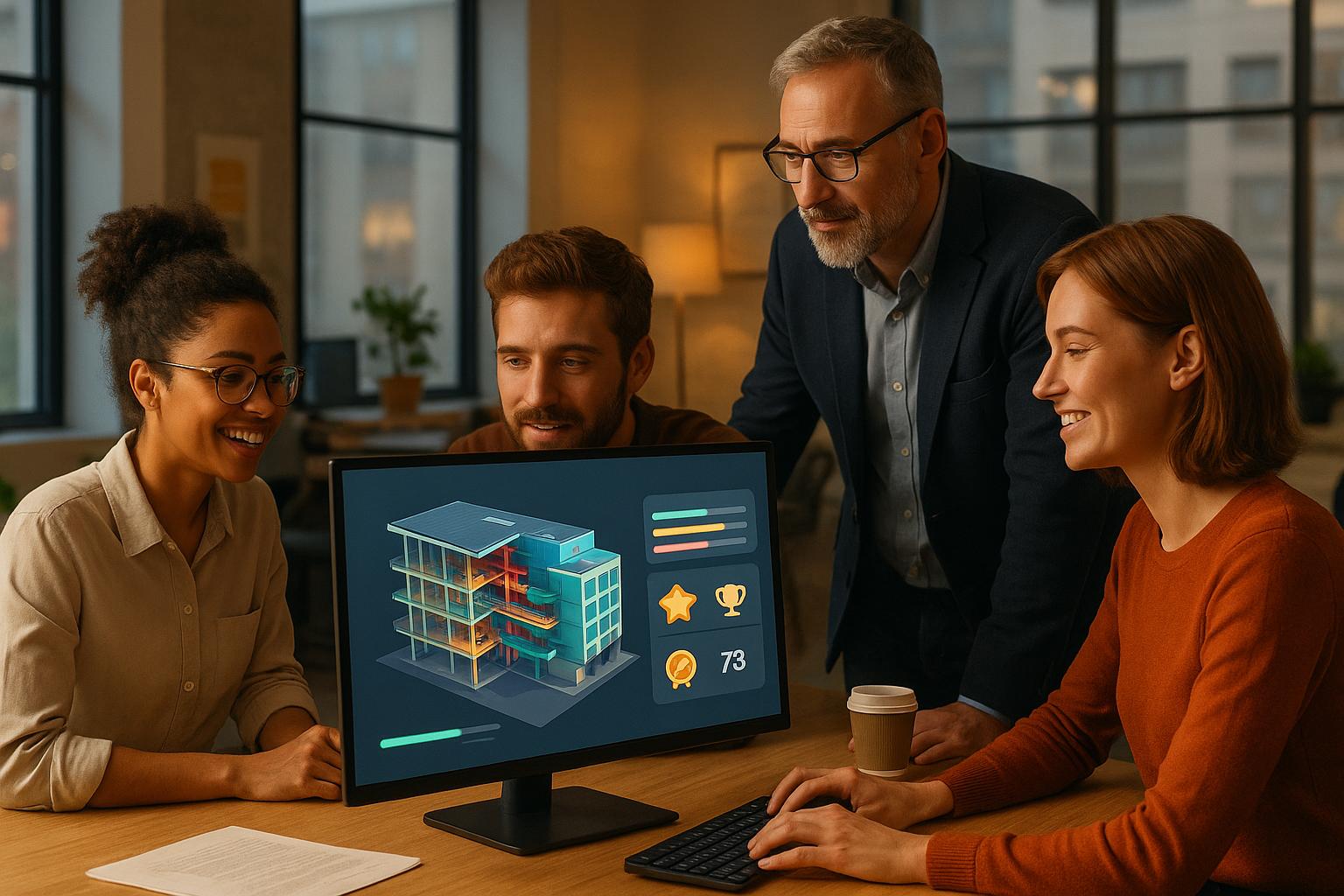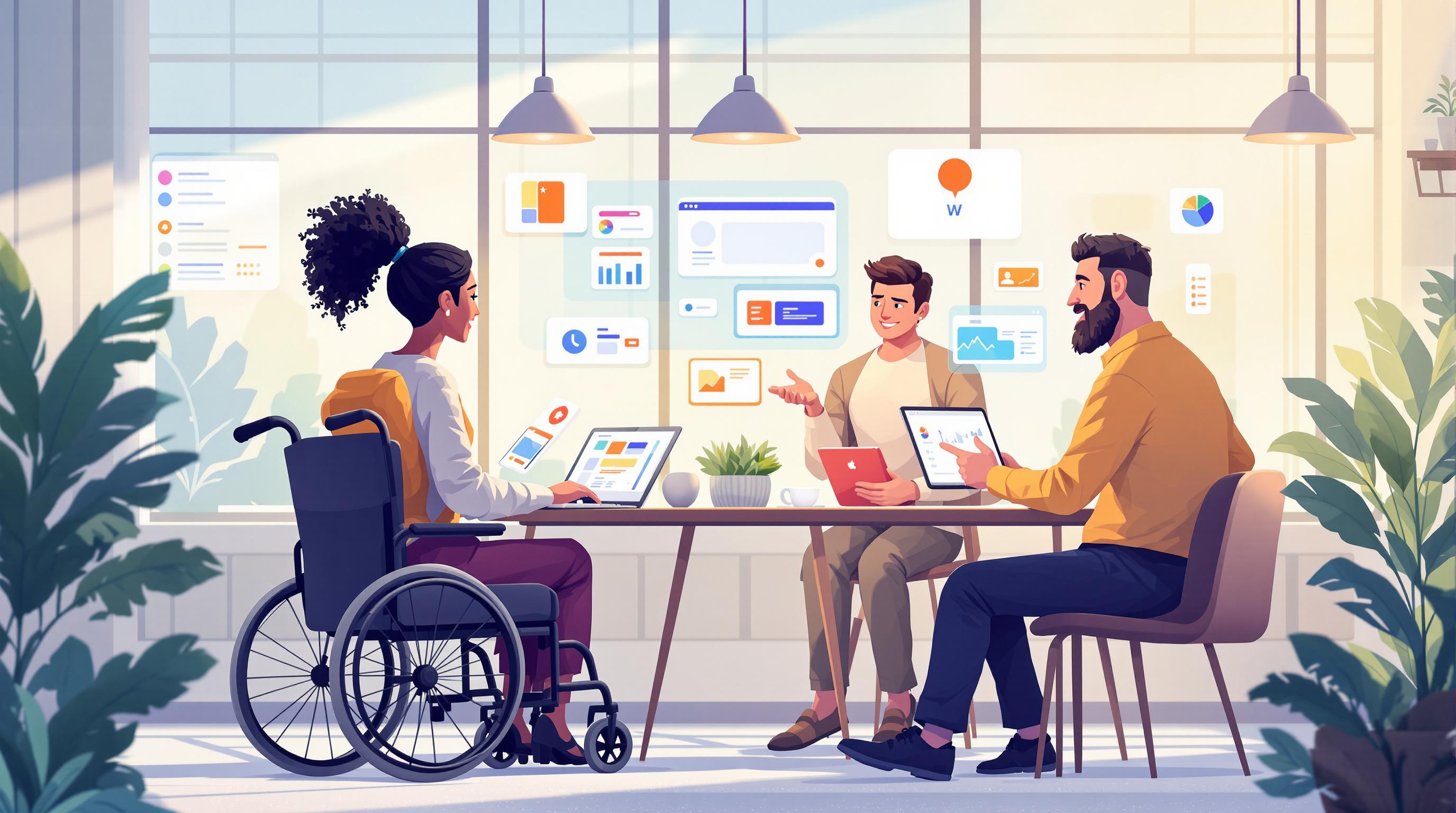Gamifying BIM training platforms is transforming how professionals learn complex concepts. By integrating game-like features – such as points, badges, leaderboards, and progress tracking – platforms make learning engaging, boost motivation, and improve retention. Research shows gamified training increases user engagement by up to 60% and knowledge retention by 22 times compared to traditional methods.
Key Takeaways:
- Small Rewards Matter: Frequent, immediate rewards like points and badges reinforce learning habits and combat training fatigue.
- Social Features Drive Engagement: Leaderboards and team challenges encourage healthy competition and collaboration.
- MAU as a Success Metric: Monthly Active Users (MAU) is critical for tracking user engagement and platform effectiveness.
- Effective Reward Systems: Points, badges, progress tracking, unlockable content, and leaderboards cater to diverse user motivations.
- Emerging Trends: AI-driven personalization, XR technologies, and microlearning modules are shaping the future of gamified BIM training.
Platforms like AlterSquare enable startups to develop gamified BIM training solutions in just 90 days, focusing on features that enhance user engagement and scalability. By leveraging data, testing strategies, and refining gamification mechanics, organizations can achieve higher retention, better learning outcomes, and measurable business results.
Gamification in Learning: Equipping Architects & Civil Engineers with BIM Skills
Why Small Rewards Drive User Behavior
Micro-rewards are a powerful tool for keeping BIM learners engaged over the long term, even after their initial excitement about training fades.
How Rewards Affect Motivation and Learning
Small rewards tap into fundamental motivators, making the learning process enjoyable and rewarding. For example, when users finish a modeling exercise and immediately earn points or badges, it creates a positive feedback loop that helps form lasting learning habits.
According to a 2025 Deloitte study, 83% of employees prefer frequent, personalized rewards over one-time bonuses [3]. This insight translates well to BIM training environments, where learners respond more positively to consistent recognition for smaller achievements rather than waiting for rewards tied to larger milestones.
Immediate feedback is critical. When a user completes a task like clash detection, receiving instant recognition – whether through badges or points – reinforces their behavior and encourages them to continue. Over time, this builds habits that lead to consistent platform use and skill development.
Elena Rossi, VP of HR at Global Synergy Solutions, highlighted the tangible benefits of this approach:
"The combination of recognition and gamification has created a culture of excellence. Our employee satisfaction scores are at an all-time high." [1]
Personalized rewards are particularly effective because they celebrate individual progress. For instance, platforms can automatically issue rewards when users complete challenging tasks, providing real-time encouragement to continue advancing their BIM skills.
Beyond motivation, these small rewards are also a strategic way to address training fatigue.
Using Small Rewards to Fight Training Fatigue
Training fatigue is a common hurdle in technical education, especially with complex tools like BIM software. Traditional training approaches often see completion rates of just 55%, but gamified training methods boast a 90% completion rate [5].
Small rewards help learners overcome fatigue by breaking large, overwhelming tasks into smaller, manageable steps. Instead of slogging through long and monotonous training sessions, learners tackle engaging challenges that offer immediate recognition and clear indicators of progress.
POWER Engineers has seen the value of this approach in their training programs:
"We all like doing things when others acknowledge our skills in a certain area. It gives us confidence, a sense of pride, and motivation to keep learning." [4]
Progress tracking and achievement badges are particularly effective tools, as they provide learners with a visual representation of their progress [5]. Scenario-based challenges with scoring systems also maintain engagement. For instance, instead of passively watching tutorials on pipe routing in MEP systems, learners participate in hands-on challenges that reward efficiency, accuracy, and creativity.
This focus on accomplishments naturally extends into social competition, further driving user engagement.
Social Features in Gamified Training
Social elements amplify the impact of small rewards by introducing competition, collaboration, and peer recognition [6]. When learners share their achievements and compete with others, individual rewards become part of a broader, more interactive experience.
Leaderboards encourage friendly competition, motivating users to improve their BIM modeling speed and accuracy as they compare progress with peers [5]. Collaborative platforms also reward teamwork, recognizing contributions to group objectives and fostering a sense of shared success [6].
Real-world examples highlight the effectiveness of social gamification. Nike+ Run Club, for instance, leverages challenges and leaderboards to create a strong sense of community, leading to a 15% increase in user retention for those who engage with these features [6]. Similarly, Khan Academy’s gamified learning approach has improved student test scores by 21% [6].
In BIM training, team competitions and collaborative goals mirror real-life project scenarios. Learners working together on virtual construction projects not only build technical skills but also enhance their ability to collaborate effectively. Recognition for group achievements reinforces their motivation to continue improving.
LinkedIn’s "Profile Strength" feature is another example of how combining progress indicators with social elements can drive engagement. Users with completed profiles are 40% more likely to be contacted by employers [6], showcasing how gamified progress tracking can lead to tangible career benefits.
These social dynamics set the stage for structured reward systems that can further enhance BIM training experiences.
Reward Systems That Work for BIM Training
Expanding on the idea of small rewards, let’s dive into specific systems that can drive user engagement and boost monthly active users (MAU) on BIM training platforms. A well-thought-out reward system tailored to the learning environment can make all the difference. By understanding which rewards work best for different scenarios, you can create a system that delivers real results. Here are the most effective reward types for BIM training.
Best Reward Types for BIM Training Platforms
Points systems reward users for completing tasks like modeling exercises, quizzes, or clash detection. These points can then be redeemed for perks such as advanced courses or certifications. For example, a performance-based reward program improved key metrics by 89% in just 90 days [8]. When users see tangible benefits from their efforts, their engagement tends to skyrocket.
Achievement badges recognize specific skills, such as "Revit Modeling Expert", "Clash Detection Specialist", or "4D Scheduling Master." These badges not only validate a user’s expertise but also serve as professional credentials they can showcase.
Progress tracking systems simplify complex BIM concepts by breaking them into smaller, manageable steps. Features like progress bars or completion percentages give users a clear sense of advancement, making the learning process feel less overwhelming.
Unlockable content creates excitement and encourages sustained participation. For instance, advanced BIM workflows, exclusive templates, or expert interviews can be made accessible only after completing prerequisite modules. This approach, inspired by game progression systems, keeps users motivated to thoroughly complete earlier stages.
Leaderboards encourage friendly competition, fostering consistent engagement. Monthly challenges – such as fastest modeling times, most accurate quantity takeoffs, or top quiz scores – can keep users coming back. By offering multiple leaderboard categories, platforms can ensure that users with different strengths feel included.
In one example, the American Type Culture Collection (ATCC) implemented a reward and recognition system that led to a 10% increase in retention over a year, significantly reducing recruiting and training costs [8]. This demonstrates how effective reward systems can lead to lasting behavioral changes that benefit both users and platform operators.
Comparing Different Reward Systems
Each reward type caters to different motivations and learning styles. Here’s a breakdown of their strengths and challenges:
| Reward Type | Best For | Implementation Cost | User Engagement | Long-Term Impact |
|---|---|---|---|---|
| Points Systems | Flexible motivation and diverse tasks | Medium | High | Excellent – users control their experience |
| Achievement Badges | Skill recognition and career growth | Low | Medium-High | Good – provides lasting credentials |
| Progress Tracking | Goal-oriented learners | Low | Medium | Good – clear path to advancement |
| Unlockable Content | Sustained engagement and exclusivity | High | High | Excellent – fosters long-term value |
| Leaderboards | Competitive users and community building | Low | High | Medium – depends on active participation |
Points systems stand out by letting users tailor their rewards, which research shows can significantly boost motivation – 78% of employees work harder when their efforts are recognized [9].
Achievement badges are ideal for learners who value professional recognition. With 63% of construction firms worldwide requiring BIM expertise for project managers [10], these badges can become valuable career tools.
Progress tracking helps users tackle complex topics step by step, while unlockable content keeps them invested by offering exclusive features as rewards. Leaderboards, when thoughtfully designed, encourage competition without alienating users who prefer a different pace.
Combining these reward types creates a well-rounded system that appeals to a wide range of learners. Organizations with strong recognition programs report up to 20% higher engagement [7], making a comprehensive reward strategy essential for sustained growth. By understanding these systems, you’re better prepared to integrate gamification into your BIM training platform for maximum impact.
sbb-itb-51b9a02
Adding Gamification to Your BIM Training MVP
Incorporating gamification into your BIM training MVP can make learning more engaging and effective. Start small, prioritize learning goals, and refine your approach based on user feedback.
Step-by-Step Guide to Gamifying BIM Training
Define clear objectives and align game elements with training goals. Identify the behaviors you want to encourage – whether it’s improving course completion rates, enhancing skill retention, or increasing daily logins. For example, Duolingo boosted user engagement by gamifying login streaks, focusing on a measurable behavior that indicated success [13].
Understand the behaviors of your top-performing users. Dive into what actions these users take. As Dr. Julia Huprich, former VP of Learning Science at Intellum, explains:
"It’s not about doing something, it’s about doing the right thing." [13]
Profile your users to understand their motivations. BIM professionals may be driven by career growth, skill recognition, or competition. For instance, project managers might aim for certifications, while BIM coordinators could value peer acknowledgment. Tailor game elements to these motivations for maximum impact.
Select game elements that align with your goals. Reward systems, feedback loops, and time-based challenges are great starting points. Keep it simple – introduce one or two elements initially. A construction firm reduced workplace accidents by 30% by turning safety drills into interactive challenges [11].
Pilot features with a small group. Gather feedback early to identify issues and refine your approach.
Prioritize learning objectives over mechanics. Clear criteria and progression keep users motivated and engaged [12].
Start with small, frequent rewards, then increase difficulty over time. This gradual progression builds momentum and keeps users invested [12].
Once you’ve laid the groundwork, choose tools to bring these game elements to life.
Tools and APIs for BIM Platform Gamification
Selecting the right tools can streamline your gamification process. With the global gamification market projected to hit $116.6 billion by 2032 [15], there are plenty of options to explore.
Open-source solutions like Open edX paired with Raccoon Gang Gamification are ideal for creating flexible, scalable platforms. According to the Head of Instructional Design at Raccoon Gang:
"Educational gamification tools allow instructional designers to align gamified content with course objectives, enabling educators to experiment with new methods to engage students." [14]
Enterprise platforms such as Docebo are better suited for multi-audience training programs, offering advanced analytics and user management.
Lightweight tools like H5P are perfect for quick, interactive content, such as gamified quizzes or progress trackers.
When choosing tools, factor in your team’s technical expertise. Open-source options offer customization but require more technical skills, while enterprise platforms come with built-in support.
| Tool | Best For | Implementation Complexity | Cost |
|---|---|---|---|
| Open edX + Raccoon Gang | Comprehensive BIM training platforms | High | Low-Medium |
| Docebo | Multi-audience training programs | Medium | High |
| H5P | Quick interactive content | Low | Free |
After implementation, focus on testing and refining these features.
Testing and Improving Gamification Features
Gamification isn’t a one-and-done process – it requires constant evaluation and tweaking. Emilia Korczynska, Head of Marketing, emphasizes:
"Gamification should complement, not overshadow, core functionality. Continuously monitor your strategy, conduct A/B testing, and gather user feedback to ensure it’s driving positive results." [16]
Leverage A/B testing. Compare gamified and non-gamified groups by analyzing metrics like daily active users, session duration, and churn rates. For example, Duolingo’s streak system increased retention by 5% for each additional consecutive day of use [17].
Track key engagement metrics. Monitor user activity, retention, and feature adoption to identify which game mechanics resonate most. Salesforce’s Trailhead program, featuring badges and rankings, achieved a 40% rise in user engagement and a 20% boost in feature adoption [17].
Gather qualitative feedback. Use surveys, interviews, and analytics to uncover why certain game elements succeed – or fail.
Analyze long-term retention. Focus on sustained engagement over time, not just short-term spikes.
Iterate based on user behavior. Experiment with different mechanics and adjust based on what works. For instance, Asana’s progress bars and celebratory animations led to a 50% increase in user engagement and a 30% improvement in task completion rates [17].
Tracking Gamification Success and MAU Growth
To understand if your gamification efforts are hitting the mark, you need to focus on tracking the right metrics and analyzing data regularly. Without this, it’s tough to tell if those small incentives are actually driving user engagement.
Key Metrics for Gamified BIM Training Success
When it comes to measuring success, Monthly Active Users (MAU) and Daily Active Users (DAU) are your go-to indicators. These metrics give you a clear picture of how often users interact with your gamified BIM training platform. In fact, companies that tailor gamification to their workforce have seen a 47% rise in employee engagement [19].
Engagement metrics dive deeper into how users interact with gamified features. Keep an eye on session length, login frequency, and interaction rates. These numbers matter because 83% of employees report feeling more engaged with gamified training [19].
Performance metrics help you measure learning outcomes. Look at task completion rates, progress in skill development, and the speed at which users unlock achievements. Studies show that gamified training can lead to a 90% increase in completion rates and a 40% boost in knowledge retention compared to traditional methods [18].
Business impact metrics link gamification to real-world results. These include customer retention, conversion rates, revenue growth, and cost savings. Companies using gamification report that 75% see boosts in productivity metrics [19].
| Metric Category | Specific Metrics | Why It Matters |
|---|---|---|
| Engagement | MAU/DAU, Session Duration, Login Frequency | Tracks user interaction with gamified elements |
| Performance | Completion Rates, Skill Progress, Achievement Speed | Measures learning outcomes |
| Business Impact | Retention Rate, Revenue Growth, Cost Savings | Demonstrates ROI of gamification |
User satisfaction scores add a qualitative layer to your analysis. Tools like Net Promoter Score (NPS) can gauge how satisfied users are and whether they’d recommend your platform. Gamification has been shown to drive a 22% increase in brand loyalty [19].
Finally, don’t overlook social interaction metrics. These measure how users engage with features like leaderboards, social sharing, and referrals. Understanding these interactions can help you identify which community elements resonate most with your audience.
By focusing on these metrics, you can refine your approach and adapt your gamification strategy as needed.
Using Data to Improve Gamification Results
Once you’ve identified the key metrics, the next step is using the data to fine-tune your gamification efforts.
A/B testing and behavior analysis are powerful tools for comparing gamified and non-gamified user groups. This helps you tailor rewards and challenges to meet user preferences. For example, Duolingo uses data analytics to track user progress, leading to a 30% increase in daily usage [20]. Similarly, Classcraft tracks student behavior to boost engagement among at-risk students by 30% [20].
Focus on long-term retention rather than short-term spikes. Engaged users are 60% less likely to churn [17], so it’s essential to analyze how gamification impacts user loyalty over time.
Feedback loops via surveys and interviews provide deeper insights to complement quantitative data. As the Vorecol Editorial Team puts it:
"Gamification harnesses the principles of game design to engage users in non-gaming contexts, effectively transforming mundane tasks into enjoyable experiences." [20]
Real-time data tracking allows you to make immediate adjustments. Deloitte, for instance, increased engagement from 50% to 80% by introducing point systems and challenges during onboarding [20]. This shows how real-time optimization can lead to significant improvements.
Personalization based on user data is another game-changer. Amazon saw a 20% sales boost during the 2019 holiday season by offering personalized recommendations [20]. Apply the same logic to your BIM training by customizing rewards and challenges.
Visual progress indicators like progress bars can also make a difference. Users are 40% more likely to complete tasks when visual feedback is present [17]. This simple addition can significantly enhance user motivation.
Finally, continuously refine your strategy by combining real-time data with user feedback. Set clear goals before implementing changes, monitor the results, and adjust your framework to align with your evolving objectives. This iterative process ensures your gamification efforts remain effective and relevant.
The Future of Gamified BIM Training Platforms
BIM training is undergoing a transformation, with gamification reshaping how professionals learn and engage with complex building information modeling concepts. As we look ahead, several key trends are setting the stage for the growth and effectiveness of gamified BIM training platforms. These advancements build on current strategies to push the boundaries of what’s possible in professional learning.
One major trend is AI-driven personalization, which is redefining gamification. By analyzing how learners interact with the platform and their performance patterns, AI systems can deliver customized content tailored to individual learning preferences [21][22]. This means difficulty levels can adjust automatically, relevant modules can be suggested, and reward systems can be fine-tuned to keep users motivated and engaged.
Another exciting development is the integration of Extended Reality (XR) technologies, including VR, AR, and MR. These tools create immersive learning experiences, such as virtual site visits and hands-on practice in simulated, risk-free environments [2]. Imagine exploring 3D models, manipulating building components, or running construction scenarios – all from your desk.
Microlearning modules are also gaining momentum as professionals seek concise, flexible ways to learn. These bite-sized lessons allow users to acquire skills in small, manageable chunks while staying up to date with industry trends [2][22]. When combined with instant feedback and small rewards, microlearning keeps learners motivated and avoids the overwhelm that can come with more intensive training programs.
Additionally, interdisciplinary collaboration is becoming a cornerstone of future BIM training platforms. By incorporating joint exercises and federated model reviews, these platforms encourage teamwork among architects, engineers, and contractors – mirroring the integrated workflows of real-world projects [2].
These trends highlight the power of gamification to create engaging training experiences that not only captivate users but also help them retain knowledge over time.
That said, implementing advanced gamification isn’t without its challenges. Striking the right balance between fun and learning objectives is critical. Overemphasizing external rewards could undermine intrinsic motivation [24]. The goal is to design systems that align with meaningful learning outcomes and shared values.
A great example of success in this space is AlterSquare, which has rapidly advanced gamified BIM training platforms. By integrating cutting-edge technologies, they’ve enhanced user engagement and improved real-world BIM skills. Their platforms combine interactive mechanics, compelling storylines, and real-time feedback to encourage critical thinking, problem-solving, and spatial understanding [23].
For startups looking to innovate in this area, the potential is enormous. Consider this: IBM reported a 70% increase in knowledge retention among employees using gamified content, while Cisco Systems saw training completion rates rise by over 50% with gamification [24].
The future belongs to BIM training platforms that seamlessly merge emerging technologies with a focus on measurable learning outcomes. Success will depend on creating systems that not only attract users with engaging features but also deliver practical skills and knowledge that translate directly to real-world BIM applications.
FAQs
How do small rewards like points and badges improve engagement in BIM training?
Small rewards like points and badges can make BIM training much more engaging by celebrating users’ progress and achievements. These small tokens of recognition give learners a sense of accomplishment, keeping them motivated to stick with their training and continue improving.
By appealing to the universal desire for recognition and a bit of friendly competition, these rewards boost participation, create a positive atmosphere for learning, and leave users feeling more satisfied with their experience. Over time, this approach can lead to better retention rates and more consistent involvement with the platform.
How do social features like leaderboards and team challenges enhance engagement in gamified BIM training?
Social features like leaderboards and team challenges play a big role in making BIM training more engaging. Leaderboards highlight individual progress and accomplishments, sparking a sense of friendly competition that pushes participants to stay active and aim higher.
Meanwhile, team challenges focus on collaboration, bringing users together to work toward common goals. This teamwork not only keeps participants motivated but also builds a sense of community within the platform, which can lead to better learning experiences and long-term retention.
How do AI-driven personalization and XR technologies improve the learning experience in gamified BIM training?
AI-powered personalization takes learning to a whole new level by tailoring materials to fit each learner’s specific needs, preferences, and progress. This approach keeps learners motivated by delivering content that aligns perfectly with their skill levels and objectives.
At the same time, Extended Reality (XR) technologies – like Virtual Reality (VR) and Augmented Reality (AR) – offer immersive, hands-on experiences. These realistic simulations simplify complex BIM concepts, making them easier to grasp while boosting retention and practical skills. Together, these tools transform gamified BIM training into a more engaging and customized experience for every learner.
Related Blog Posts
- Legacy CAD to BIM: A Modernization Roadmap for AEC Startups
- The BIM Integration Playbook: Technical Considerations for AEC Startups
- Overcoming Adoption Barriers: Getting AEC Professionals to Embrace New Technology
- Onboarding in 30 Minutes or Less: Designing Frictionless First-Time Experiences for BIM SaaS









Leave a Reply